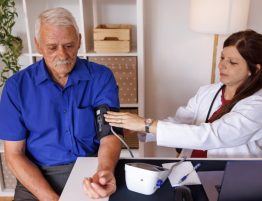
Intensively lowering blood pressure may lead to structural changes in the brain that help it clear away toxins and other byproducts, potentially reducing the risk for dementia, new research suggests.
This is the first study to look at whether intensive blood pressure treatment can slow or reverse the volume of brain tissue taken up by perivascular spaces, the pathways around blood vessels used to clear toxins. The findings will be presented Feb. 8 at the American Stroke Association’s International Stroke Conference in Dallas. They are considered preliminary until full results are published in a peer-reviewed journal.
“If the brain cannot properly clear toxins and metabolic byproducts, they will accumulate and may contribute to the development of dementia,” lead author Dr. Kyle Kern said in a news release. Kern is a clinical research fellow in the intramural stroke branch of the National Institute of Neurological Disorders and Stroke, a division of the National Institutes of Health in Bethesda, Maryland.
“Some research has proposed that the pulsations of the cerebral arteries with each heartbeat help to drive the clearance of these toxic brain byproducts in the perivascular spaces,” Kern said. “However, high blood pressure over the long term stiffens arteries, impairing function and the ability to clear toxins, resulting in enlargement of perivascular spaces.”
A blood pressure reading has two measurements: systolic pressure, the top number, measures the force against artery walls when the heart beats; diastolic pressure, the bottom number, measures the same force between beats. The American Heart Association defines hypertension, or high blood pressure, as a systolic reading of 130 mmHg or higher or a diastolic reading of 80 mmHg or higher.
Researchers compared magnetic resonance imaging scans of the brains of 442 people with high blood pressure who were given either intensive treatment (lowering systolic blood pressure to 120 mmHg) or standard treatment (lowering the systolic to 140 mmHg). The participants were 67 on average and were part of the nationwide SPRINT-MIND MRI substudy.
Brain scans were taken at the time of enrollment and after an average follow-up of 3.9 years.
As people age or have more cardiovascular risk factors, perivascular spaces in the brain can become enlarged, blocking the pathway so toxins don’t clear the brain. The volume of brain tissue in these spaces was similar for both groups when the study began. But after nearly four years, only the group given intensive blood pressure treatment saw a significant decrease in volume, suggesting that the aggressive treatment may reverse the effects of high blood pressure on these pathways.
“The next step is to determine how perivascular spaces relate to cognition and cognitive decline in the SPRINT-MIND trial,” Kern said. “That trial included high-quality cognitive function assessments at multiple time points, and forthcoming investigations from the trial will describe how perivascular spaces may relate to the effect of intensive blood pressure control on cognitive decline.”
In the news release, Dr. Philip B. Gorelick, chair of the American Heart Association’s Stroke Brain Health Science Subcommittee, said the findings, while not yet proven, imply “that the intensive systolic blood pressure lowering may eventually be associated with better clearance of brain toxins and metabolic byproducts and thus provide a better chance to maintain brain health.”
Gorelick, a professor of neurology in the Ken & Ruth Davee Department of Neurology at Northwestern University’s Feinberg School of Medicine in Chicago, was not involved in the study.
If you have questions or comments about this American Heart Association News story, please email [email protected].







